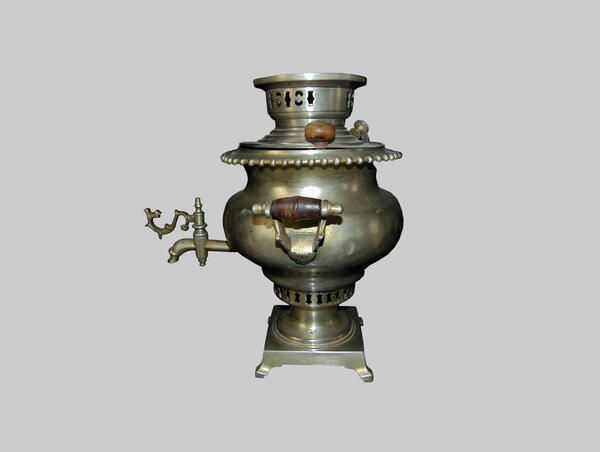The large sitting room presents a variety of exhibits associated with secular noble tea drinking: some exquisite china made by the renowned M.S. Kuznetsov porcelain and faience production Comradeship, an elegant oval table, produced at one of the factories of the great master furniture maker Michael Thonet, his Viennese chairs and armchairs, famous all over the world. Of course, the samovar is at the head of the tea collection.
According to popular legend, the samovar was brought to the Russian Empire by Peter I, but this is not so: in fact, they spread to the Russia Empire after his death. No less popular is the erroneous opinion that the birthplace of the Russian samovar is Tula: in fact, they first began to be produced in 1740 in the Western Urals on the territory of the modern Sverdlovsk region. The place of production of the silvery samovar displayed in the large sitting room is unknown. Moreover, its quite modern device suggests that it was released at the beginning of the twentieth century. This samovar consists of a container for water, a circle located at the top of the vessel and a pallet and a tap. It also has handles that are traditional for samovars, which are significantly spaced from the body: they were positioned in such a way so as not to accidentally touch a very heated vessel.
The samovar gradually became one of the key symbols of a Russian household: its popularity grew throughout the 18th-19th centuries. For two incomplete centuries, the samovar has managed to steal the hearts of people of various cultural backgrounds and classes. Of course, this also caused his technical samovar: the quality of workmanship, materials, styles changed. Initially, copper was used to make samovars, later brass came in its place.
Back in the 18th century, samovars were very expensive, so many of them at the turn of the 19th century were made at a high artistic level. Samovars of the second half of the XIX - early XX centuries became the subject of mass culture of that time. Most of them were already assembled industrially from stamped and cast parts. More massive, mass-produced samovars combined a lower cost with a simpler appearance, while it would be wrong to claim that they have completely lost their aesthetic properties.
According to popular legend, the samovar was brought to the Russian Empire by Peter I, but this is not so: in fact, they spread to the Russia Empire after his death. No less popular is the erroneous opinion that the birthplace of the Russian samovar is Tula: in fact, they first began to be produced in 1740 in the Western Urals on the territory of the modern Sverdlovsk region. The place of production of the silvery samovar displayed in the large sitting room is unknown. Moreover, its quite modern device suggests that it was released at the beginning of the twentieth century. This samovar consists of a container for water, a circle located at the top of the vessel and a pallet and a tap. It also has handles that are traditional for samovars, which are significantly spaced from the body: they were positioned in such a way so as not to accidentally touch a very heated vessel.
The samovar gradually became one of the key symbols of a Russian household: its popularity grew throughout the 18th-19th centuries. For two incomplete centuries, the samovar has managed to steal the hearts of people of various cultural backgrounds and classes. Of course, this also caused his technical samovar: the quality of workmanship, materials, styles changed. Initially, copper was used to make samovars, later brass came in its place.
Back in the 18th century, samovars were very expensive, so many of them at the turn of the 19th century were made at a high artistic level. Samovars of the second half of the XIX - early XX centuries became the subject of mass culture of that time. Most of them were already assembled industrially from stamped and cast parts. More massive, mass-produced samovars combined a lower cost with a simpler appearance, while it would be wrong to claim that they have completely lost their aesthetic properties.



